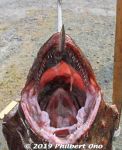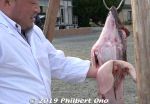Kita-Ibaraki Fishing Culture 北茨城漁業文化
|
|
|

Hirakata Port is a major fishing port in Kita-Ibaraki.
|
|

Hirakata Port has a fish market that holds a fish auction in the afternoon. This is a typical wholesale fish market in Japan. Open-air, flat roof with a concrete floor next to fishing boats.
|
|

It's unlike the old Tsukiji fish market or the new Toyosu Market in Tokyo.
|
|

Hirakata Port's main catch is the monkfish/goosefish (あんこう), a type of anglerfish. Ibaraki Prefecture's coast is one of Japan's prime areas for monkfish. These are all monkfish being auctioned in the afternoon. 平潟港 せり見�
|
|

Monkfish/goosefish (あんこう), a type of anglerfish. They are most prized for their liver (ankimo), a local delicacy.
|
|

There are many species of angler fish in the world. The one caught in Japan is this one, Lophiomus setigerus.Monkfish has a big head, wide mouth, and a lure on the forehead to attract small fish. Looks kind of grotesque and lives on the ocean floor.
|
|

Besides monkfish, other fishes are sold at auction. This is not yet a tourist attraction since we were the only outsiders there.
|
|

Each pile of fish is for a single bid.
|
|
|
|
|

Sea eels or anago.
|
|

Cleaning up the fishing boat. Bycatch dumped overboard, but the birds are not picking it up.
|
|

Oh look, something's hanging there...
|
|

It's Kita-Ibaraki's famous fish and delicacy, monkfish, in the flesh. This one is 5 or 6 years old, weighing 12.7 kg. Only the female monkfish is eaten. The males are too small.あんこう
|
|

Look into the big mouth and see another set of teeth on the throat. All the teeth are pointed inward so its pray cannot escape. Like the aliens in the movie "Alien."
|
|

Monkfish being skinned and carved up by an expert chef. Since the monkfish is too slimy and slippery on a cutting board, it is hung like this for carving. It's a lot easier to cut up this way.He first takes off the skin (loaded with collagen).
|
|

The chef is holding the liver (ankimo), the most prized part of the fish.
|
|

The white meat of monkfish.
|
|

This is monkfish hot pot (dobojiru ankou-nabe) どぶ汁 with monkfish parts in a miso broth. I didn't have any problem eating it. The flavor was certainly not objectionable, it's just another kind of fish.It was already prepared for us and it wasn't the fish we saw carved.
|
|

Akatsukien onsen minshuku dining room where we had monkfish hot pot. ¥14,000/night including dobujiru. 民宿 暁園
|
|

Yo-soro Fishing History Museum, 5 min. by taxi from JR Otsuko Station. Pretty large facility with local fishing-related exhibits. 北茨城市漁業歴史 資料館「よう・そろー」
|
|

Welcome mat saying "Yo-soro" which means "Go ahead" for boat navigation.
|
|

In Kita-Ibaraki, the Yo-soro Fishing History Museum's centerpiece exhibit is this wooden boat (祭事船) used in the Hitachi-Otsu Ofune Matsuri boat festival held every 5 years (常陸大津御船祭り).
|
|

It's the city's grandest festival and very unique because this boat is pulled on city streets instead of sailing on the water.
|
|

About 500 people drag this boat along a 1,200-meter route of paved streets. They lay wooden beams on the road for the boat to traverse on.
|
|

The boat, with shrine priests and musicians aboard, is rocked side to side as it is dragged on the street for several hours. This festival will be held on May 2nd–3rd, 2019. At least 160,000 spectators are expected to see it.
|
|

Short video of Hitachi-Otsu Ofune Matsuri boat festival.
|
|

The museum also has display panels showing the tsunami damage suffered by Kita-Ibaraki. Ibaraki Prefecture, being on the southern fringe of the Tohoku Region, suffered major earthquake and tsunami damage in March 2011.Kita-Ibaraki being closest to the Tohoku Region on the coast, suffered the most in Ibaraki Prefecture. The flat sandy beaches were overcome by the tsunami (second wave around 5 meters high) that caused much damage to Kita-Ibaraki. This is the Hirakata area after the tsunami. Besides major damage along the coast, the interior areas had numerous landslides, collapsed walls, and damaged roads due to the quake.
|
|

Ten people in Kita-Ibaraki died directly or indirectly due to the tsunami/earthquake and 186 injured. Over 8,000 homes in Kita-Ibaraki were damaged and up to 5,000 people had to evacuate to emergency shelters.These numbers pale in comparison to the three Tohoku prefectures, so Ibaraki doesn't get much attention with regard to 3-11, although the Emperor and Empress did visit Kita-Ibaraki in late April 2011.
|
|

Display of all the fishes caught in Kita-Ibaraki.
|
|

Yo-soro Museum also has this kami-shibai storytelling room. Story about British whalers who landed on Otsuhama beach in Kita-Ibaraki in May 1824 in search of food and water.It was during the time Japan largely prohibited contact with foreigners. By the 1800s, whaling ships from the West were frequently seen off the coast of Japan. In May 1824, multiple British whaling ships appeared off the coast of Kita-Ibaraki.
|
|

The crew suffered from scurvy due to the lack of vitamin C. They needed water and vegetables so 12 British whalers landed on Otsuhama beach in Kita-Ibaraki. They were willing to barter guns, spears, gold, etc., as payment. (大津浜事件)
|
|

However, the 12 whalers were instead held captive by the local samurai. They were tied to plum trees or confined to caves. More British ships arrived seeking the release of the prisoners.Also, the Mito Clan also brought in neighboring clans like the Taira Clan as reinforcement for a potential battle. Cannons were pointed at each other, but a conflict was averted by giving the whalers the water and food that sent them along their way away from Japan. In return, the whalers gave guns, spears, felt, gold, and silver as payment and had to promise not to approach Japan again.
|
|

Onsen Minshuku Uohiko lodge near Hirakata Port. Ankou-nabe is a specialty. Recently renovated. 温泉民宿 魚彦
|
|

Minshuku Uohiko uses natural hot spring for the bath.
|
|

Standard size room in Minshuku Uohiko.
|
|

Large room in Minshuku Uohiko.
|
|

JR Isohara Station welcome sign.
|
|

An-chan and Kou-chan mascots in Aloha shirts.
|
|
|
|
|